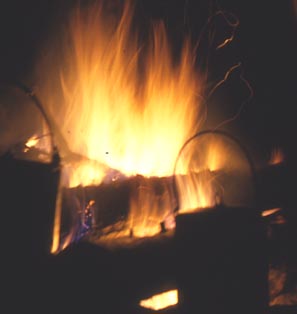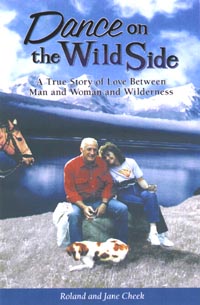a weblog sharing info on outdoor skills and campfire musing by a guy who spends a bunch of time in pursuit of both
CULTURE
WHERE -
TALES ARE TOLD OF
Welcome to Roland Cheek's Weblog
Roland is a gifted writer with a knack for clarifying reality. Looking forward to more of his wisdom
- Carl Hanner e-mail
What is the "crisis period" in one's life? Some say entry into the teens, others claim puberty. What about leaving the nest? Or entry into college? I asked a hip friend and his immediate quip was, "Exposure to drugs . . . or finally beating them." Certainly marriage constitutes a life change. Someone else might choose entry into the job market. "Children," says my wife. But our kids, though we wouldn't trade 'em, weren't exactly "chosen" so much as just "occurred."
Psst, I've finally identified the real "crisis period."It's next year!
To access Roland's weblog and column archives
Click Here
Tip o' the Day
The caller was from an eastern metropolis. He inquired about a horseback-in, river float-out trip for his two sons, ages 12 and 14, and himself. The South Fork of the Flathead and its fabulous cutthroat trout fishing was what he really wanted. And I wanted to take these folks because he said all the right things to make me think he was seeking our type of adventure: "Yes, Roland, I'd like to introduce the boys to what a real wilderness is like;" "I'd like them to learn about nature and conservation by experiencing it, rather than merely reading about it;" "Personally, I need a break from the hectic pace of my job."
Then he asked if he could bring his .357 magnum . . .
Mistaking his meaning, I said, "Yeah, sure, it's okay. But there's not likely to be a bear problem. We've never . . ."
"I'm not worried about bears. I just want to do some target practice with my sons." And the bubble burst! Mind pictures raced like a cinema reel before my eyes. Visions of wilderness peace and solitude interrupted by thoughless people wouldn't go away. Just a few days before someone with an assault rifle blazed away late into the evening, near our end-of-the-road corral. Now here was a guy who seemed willing to do the same. Instead of attempting persuasive diplomacy, I told him what I thought.
He was silent for a long time, then sighed and said, "It's not easy to raise a couple of boys in Chicago. They're good kids and my wife and I work hard at instilling a firm set of values into them. Me? I'd like them to have a love and appreciation for the things I cherish. The right and opportunity to own and shoot firearms is one of those things."
He sighed again. "What is wilderness for, Roland, if it's not for a father to teach his sons how to shoot? Or fish? or smell the roses? Do you know how many places there are in Chicago where I can take my sons to teach them how to safely use a handgun?"
"No, but . . ."
"Maybe your interpretation of what purpose wilderness is for is too narrow -- have you ever thought about that?" He hung up abruptly.
I did think about it and I became ashamed. Surely wilderness should be a place where a citizen might indulge in historical pursuits difficult to accomplish where the press of civilization prohibits it. Wilderness should be a repository of opportunity for doing things the old ways.
Did I have any right to infer that wilderness was an inappropriate place for a father to teach his sons how to shoot?
No. I would consider it an inappropriate place for me to teach my son how to shoot because I dwell in a land where both place and opportunity are plentiful. But for a man from the city? Huh-uh.
I wish he'd have stayed on the phone long enough for me to admit it.
ARE FRIENDS INDEED THE FRIENDS WE NEED?
I knew of rubber rafts long before I saw one in the raw. To a clod-kicking Oregon farm boy during World War II, the fact that British Commando and American Raider units snuck onto hostile shores riding in heavy, black, inflatable boats made of rubber was akin to being privvy to war secrets. It didn't take much of an imagination to storm Tokyo's Imperial Headquarters, or ride the tide into a surprise attack on Hitler's hush-hush missile facilities at Peenemunde, Naturally, most of my needed technical information came from observing John Wayne and the rest of his Makin Island Raiders in the movie of the same name, or sitting on the edge of a theater seat as heroic British Commandos assaulted Rommel's Tunisian headquarters in the movie "Desert Fox." But me actually get to touchy-feely a real-life life raft before the war was a half-decade past? No.
I suppose surplus life rafts hit metropolitan markets years before either they or Army/Navy surplus stores trickled down to small town Oregon. Then, about the time I was a sophomore in high school, our town picked up both. Naturally, I spent lots of time walking the crowded aisles of that surplus store, fingering web belts and helmets and jungle knives. But nothing held my attention as much as the big, yellow, 7-man life raft that hung from the store's ceiling joists. By then, war hero Eddie Rickenbacker's survival story in a Pacific Ocean life raft was out in book form -- and I was looking at the exact-same kind of life raft in which he and his six comrades floated to survival!
No way could I afford a new (old, surplus) life raft like the one hanging in the Army/Navy store, not on my paper route salary. But not more than a couple of years passed before I snatched up a used (old, worn out, surplus) 7-man life raft. As you might've guessed, it took most of an eight-hour shift just patching holes in that "bargain" rubber raft.
That first raft was cumbersome, and it was heavy. But it floated if I gave the pump a few vigorous strokes every ten minutes or so. Still, I couldn't see riding the surf into Makin Island in such a sorry craft, so I kept my eyes peeled. Thus it was that the Army/Navy store received a new shipment of surplus rafts. Miraculously, their shipment arrived at about the same time my financial affairs made an upward blip and I purchased one of the new, improved 5-man rafts.
That 5-man raft was a light-years improvement on the my first raft. First of all, it had a vee-prow on it that made it possible to row into at least a gentle breeze on a mountain lake. Too, it weighed only 60 pounds, instead of the first one's 85, so the 5-man was more practical for getting to those mountain lakes. It was easier to guide downriver during duck season, too.
I was so proud of my new (old) 5-man raft and its pointed prow that I sought to prove how versatile it was by fitting it with a mast, rudder, and sail and launching it in wind-swept Diamond Lake, in the Oregon Cascades. I hugged Jane and each of our children, then leaped into my new (old) life raft and, standing by the mast, shouted, "Sail on!" Unfortunately I'd overlooked at least one vital piece of reconditioning -- a keel! Without anything with which to "bite" the water (no, the rudder proved useles without a keel) the raft merely bounced merrily along atop the waves.
I tried turning into the wind, to no avail. Then I picked up the oars and put my strong back against the wind, to no avail. I furled the mast and tried rowing agains the wind, to no avail. I shipped the rudder and tried rowing against the wind to no avail.
Some hours later, Jane and the kids finally found me sitting dejectedly on a swimming beach at the southern end of Diamond Lake, "I thought you were going to sail back to us," she brightly exclaimed.
When we moved to Montana in 1964, the old 5-man came with us, despite a dilapidated condition brought about through continued hard use. Though there were much more opportunities to use a raft in Montana, the old worn rubber proved incapable. It was given a decent burial.
A decade passed. By then I was guiding others to adventure in the Bob Marshall Wilderness and the great cutthroat fishing in the South Fork of the Flathead beckoned. I did a feasibility study and decided it practical to pack rafts to the headwaters by horseback, then launch them for several days of leisurely floating and fishing downstream. I cast about for suitable inflatables and found the ground rules had changed; there was a world-wide market for tough, inflatable rafts for both whitewater adventure, and as yacht tenders. A huge array of models and sizes awaited the discriminating user. I settled on three rafts in two styles and sizes. Two were 14-foot double-ender "river runner" style with 18-inch tubes, and one was a 13-foot single-ender with 15-inch tubes. Each of the brand-spanking new rafts were made of a new, tougher-than-rubber fabric that did not, like rubber, deteriorate when exposed to sunlight.
Eventually (15 years after launching our float trips) we sold our outfitting and guiding service and found ourselves raft-less. God was looking out for us though, by capsizing a couple who were dear friends of ours, and so frightening them that they gave their raft to dear friends of their (us).
Unfortunately, the last three times we've ran a section of whitewater near our home, I've been thrown from the boat. We still think of the people who so generously gave us the raft as friends.
I guess.
Roland Cheek wrote a syndicated outdoors column (Wild Trails and Tall Tales) for 21 years. The column was carried in 17 daily and weekly newspapers in two states. In addition, he scripted and broadcast a daily radio show (Trails to Outdoor Adventure) that aired on 75 stations from the Atlantic seaboard to the Pacific Ocean. He's also written upwards of 200 magazine articles and 12 fiction and nonfiction books. For more on Roland, visit:
www.rolandcheek.com
Recent Weblogs
Tuesday, February 19, 2008
for more info about these and other Roland Cheek books
There's a bunch of specific info about Roland's books, columns, archives and radio programs. By clicking on the button to the left, one can see Roland's synopsis of each book, read reviews, and even access the first chapter of each of his titles. With Roland's books, there's no reason to buy a "pig in a poke."
for detailed info about each of Roland's books
Read Reviews
Read their first chapters
For interested educators, this weblog is especially applicable for use in history, relationships, and government classes, as well as for journalism students.
Roland, of course, visits schools. For more information on his program alternatives, go to:
NEXT WEEK:
WHY WALK WHEN THERE'RE SO MANY HORSES TO RIDE?
www.campfireculture.com
The Phantom Ghost of Harriet Lou is a 352-page book about "the creature" that Roland claims "took me to the wildlife dance." Packed with exciting tales from the years he both hunted elk, and guided others to their lifetime dreams
The best of Roland's 2,700 newspaper columns and radio program scripts. Mostly humor, all personal
Dance On the Wild Side, the story of Roland's & Jane's life together, from childhood sweethearts through five decades of wild adventure!
Two exciting books about the creature Roland says "keeps me dancing."
Learning To Talk Bear is Roland's best selling book, now in its 5th printing. The book describes Roland's own learning experience about the great beasts, profiling several different animals throughout portions of their lives.
Chocolate Legs is an entire book about a single charismatic Glacier National Park grizzly bear who became infamous, with ink spread across Associated Press and the New York Times.
Montana's Bob Marshall Wilderness 9 X 12 Coffee Table book, with 97 full color photos on 80 pages, PLUS 10,000 words of "how-to," "where-to" text about the Wlderness one Chief of the U.S. Forest Service called "The Crown Jewell of Our Wilderness System," and another called "The Flagship of America's Wilderness Fleet." The first book ever published about that splended land God insisted on keeping as his own -- just the same as in 1982, when Roland photographed and wrote the book.
to send this weblog to a friend
to tell Roland what you think of his Campfire Culture weblog
to visit Roland's newspaper columns and weblog archives
source links for additional info








